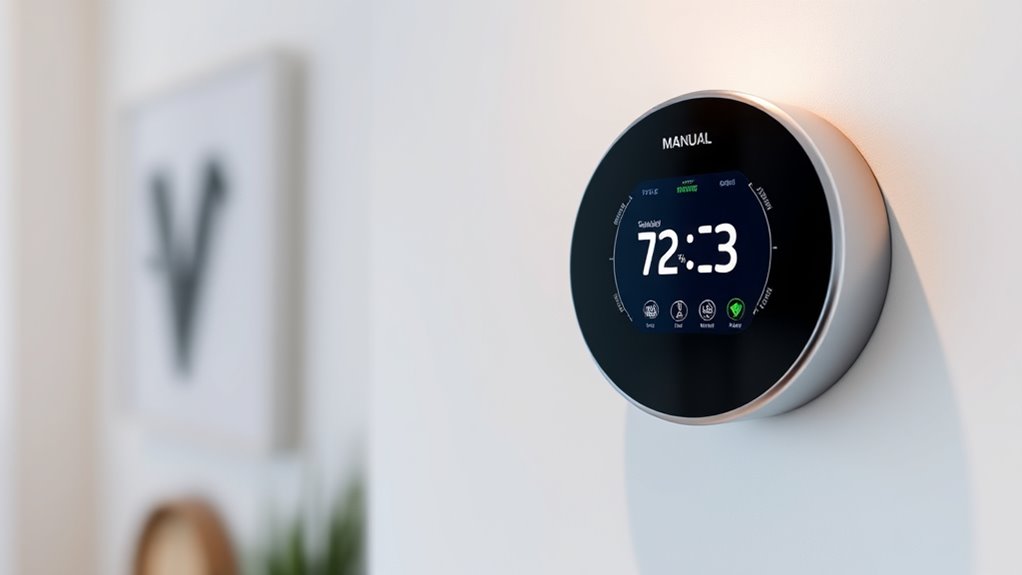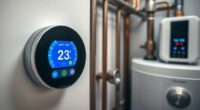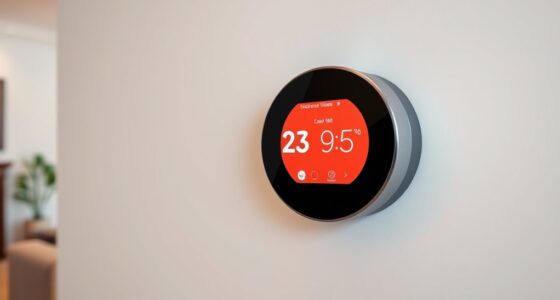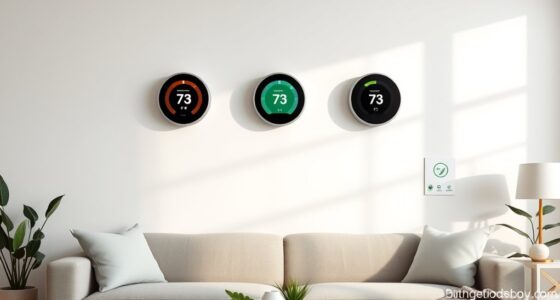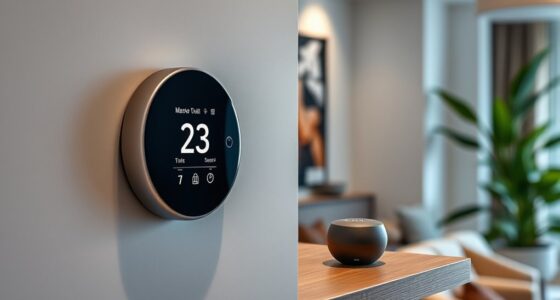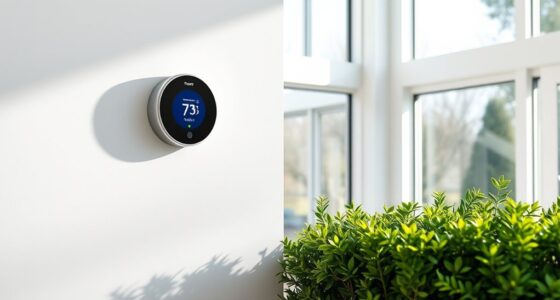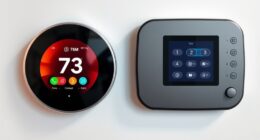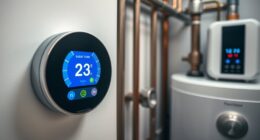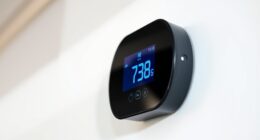If you’re looking for the best smart thermostats with manual scheduling options, I recommend checking out models like the Google Nest Learning Thermostat, ecobee SmartThermostats, and Sensi Touch, which offer easy customization for your routines. Many support multi-stage HVAC control, touchscreens, and voice compatibility, making adjustments simple. These devices help optimize comfort and energy savings. Keep exploring, and you’ll find detailed insights on features and setups to suit your home.
Key Takeaways
- Many leading models like Nest Learning and ecobee support customizable weekly or daily schedules for tailored climate control.
- User-friendly interfaces and app controls allow easy manual adjustments and overrides to existing schedules.
- Some thermostats offer multi-zone scheduling, enabling precise temperature control in different rooms or areas.
- Compatibility with voice assistants (Google Assistant, Alexa, Siri) facilitates quick manual adjustments via voice commands.
- Installation ease and clear setup guides ensure users can create and modify manual schedules without professional help.
Google Nest Thermostat, Smart Wifi Thermostat
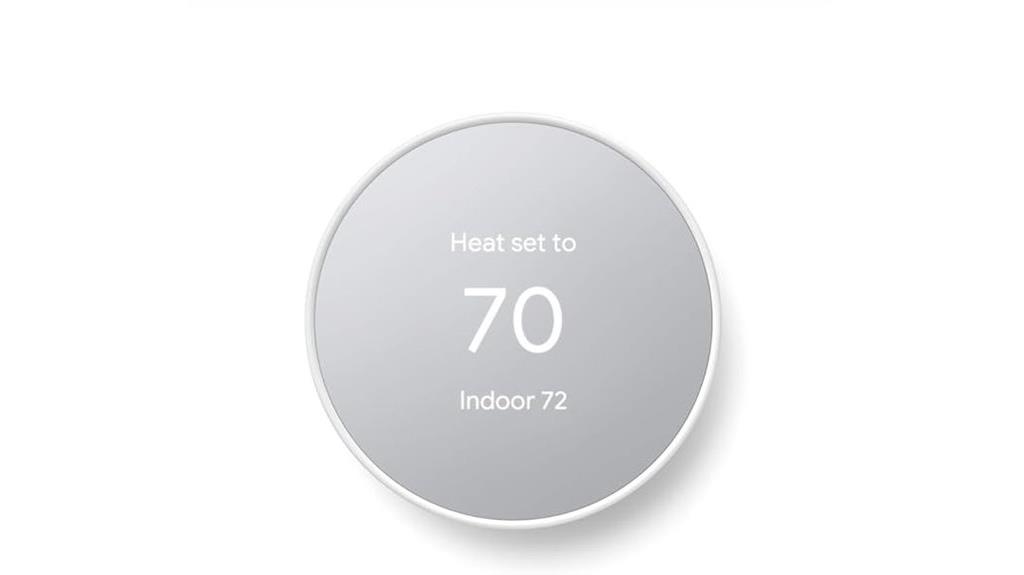
If you’re looking for a smart thermostat that seamlessly combines energy efficiency with easy customization, the Google Nest Thermostat is an excellent choice. It’s ENERGY STAR certified and helps reduce your energy bills by adjusting itself when you’re away. The device supports various HVAC systems and is simple to install, often in just 30 minutes. You can control it remotely via the Google Home app or voice commands through Google Assistant, Alexa, or your smartphone. Its sleek LCD display and intuitive interface make managing your climate easy. Overall, it’s a reliable, user-friendly option that balances smart features with straightforward manual scheduling.
Best For: those seeking a user-friendly, energy-efficient smart thermostat that easily integrates with various smart home systems and is simple to install.
Pros:
- ENERGY STAR certified, helping reduce energy bills and environmental impact
- Supports multiple HVAC systems and works without a C wire in most homes
- Easy DIY installation typically completed in 30 minutes with a sleek, intuitive interface
Cons:
- Initial setup can be challenging, especially wiring and system compatibility issues
- Limited offline functionality; dependent on internet connection for full features
- Some users report accuracy concerns at low humidity levels and occasional troubleshooting difficulties
Google Nest Learning Thermostat (4th Gen, 2024) with Nest Temperature Sensor

The Google Nest Learning Thermostat (4th Gen, 2024) with Nest Temperature Sensor stands out for its advanced self-learning capabilities and precise zone control, making it ideal for homeowners seeking a smart thermostat that adapts to their routines while allowing manual customization. It works seamlessly with most 24V systems and often requires no C wire for installation. Its sleek design features a larger display with Dynamic Farsight, providing easy-to-read information from across the room. With remote control via the Google Home app, voice commands, and compatibility with multiple sensors, it offers both intelligent automation and manual adjustments to optimize comfort and energy savings.
Best For: homeowners seeking an intelligent, adaptive thermostat with precise zone control and seamless smart home integration.
Pros:
- Self-learning capabilities that optimize heating and cooling schedules automatically
- Large, attractive display with Dynamic Farsight for easy readability from across the room
- Compatibility with most 24V systems and Matter-enabled for versatile smart home integration
Cons:
- May require professional installation if additional wiring or sensors are needed
- Higher price point compared to basic thermostats with fewer features
- Dependence on Wi-Fi for full functionality and remote control access
Meross Smart Thermostat for Home

The Meross Smart Thermostat for Home stands out for its wide compatibility, supporting 95% of HVAC systems including conventional heating and cooling, heat pumps, and heating-only or cooling-only setups. It’s easy to install, usually within 30 minutes using the Meross app setup wizard, but it requires a C-wire—if you don’t have one, you’ll need the Meross C-wire adapter. It only works on 2.4GHz Wi-Fi networks. The thermostat helps save energy with customizable schedules that keep your home comfortable and can operate even if Wi-Fi drops. Plus, you can control it remotely via the app, and it supports voice commands through Matter, Apple, Alexa, Google, and Samsung SmartThings.
Best For: homeowners seeking a versatile, energy-saving smart thermostat compatible with a wide range of HVAC systems and integrated with popular smart home platforms.
Pros:
- Supports 95% of HVAC systems, including heat pumps and conventional setups
- Easy installation within 30 minutes using the Meross app setup wizard
- Compatible with Matter, enabling seamless voice control via Apple, Alexa, Google, and Samsung SmartThings
Cons:
- Requires a C-wire for proper operation; an adapter must be purchased if absent
- Only supports 2.4GHz Wi-Fi networks, limiting connectivity options
- Not compatible with electric baseboard heaters
Sensi Touch 2 Smart Thermostat with Touchscreen Display
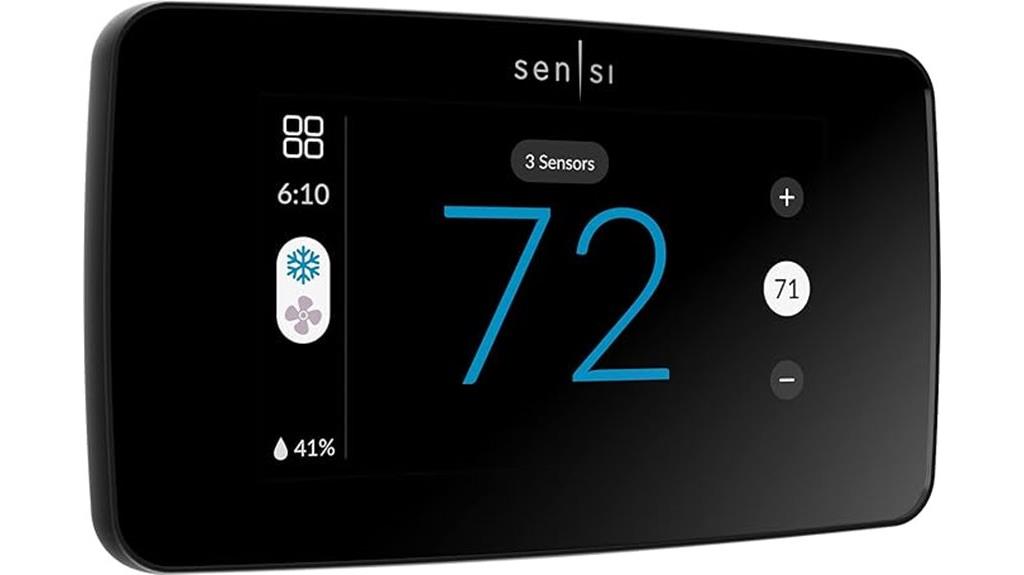
Designed for homeowners seeking intuitive control and energy savings, the Sensi Touch 2 Smart Thermostat features a sleek LCD touchscreen that makes managing your climate effortless. Its programmable scheduling, Wi-Fi connectivity, and compatibility with voice assistants like Alexa and Google Assistant offer flexible control options. Easy to install with an intuitive app, it supports room sensors to balance temperatures across spaces, boosting comfort and efficiency. ENERGY STAR certified and Title 24 compliant, it helps save around 23% on HVAC costs. Users enjoy remote access, maintenance alerts, and a straightforward interface—though some note limited low-temperature settings and occasional support challenges.
Best For: homeowners seeking an easy-to-use, energy-efficient smart thermostat with customizable scheduling and voice control options.
Pros:
- Sleek LCD touchscreen with intuitive interface for effortless management
- Supports room sensors for balanced temperature control across spaces
- Energy-saving features help reduce HVAC costs by approximately 23%
Cons:
- Limited temperature adjustment range for auxiliary heat and low-temperature settings
- Occasional difficulties accessing outside temperature data on the thermostat
- Support response times can vary, with some users experiencing challenges reaching technical assistance
ecobee Smart Thermostat Essential with Wi-Fi and Voice Compatibility
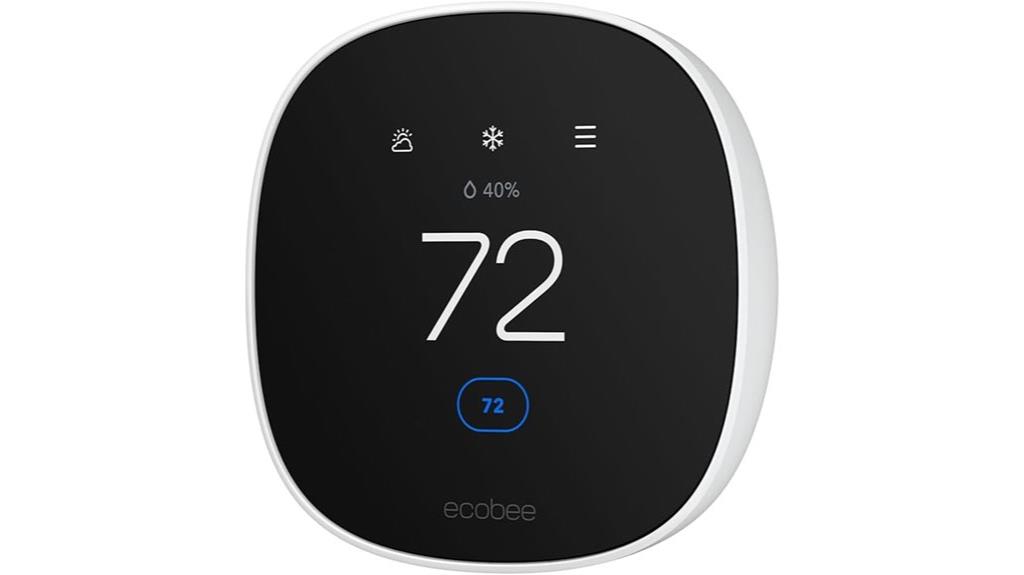
Looking for a smart thermostat that combines energy efficiency with seamless voice control? The ecobee Smart Thermostat Essential is Energy Star certified and works with Siri, Alexa, Google Assistant, and Apple HomeKit, making it easy to integrate into any smart home setup. It features an LCD display, touch controls, auto-scheduling, and fan control, perfect for managing heating and cooling systems like air conditioners, furnaces, or electric baseboard heaters. Installation is straightforward, and energy savings can reach up to 23%, often paying for itself within six months. Its compact design and reliable app make it a popular choice for those wanting modern convenience and cost-effective climate control.
Best For: homeowners seeking an energy-efficient, easy-to-install smart thermostat that integrates seamlessly with voice assistants and smart home ecosystems.
Pros:
- Easy DIY installation with straightforward setup
- Significant energy savings of up to 23%, reducing utility bills
- Compatible with multiple voice assistants and smart home platforms like Apple HomeKit, Alexa, and Google Assistant
Cons:
- Limited scheduling flexibility, with only one schedule per season
- Cannot set different schedules for different seasons without manual re-entry
- Scheduling is restricted to 30-minute intervals, not customizable to minutes
Amazon Smart Thermostat
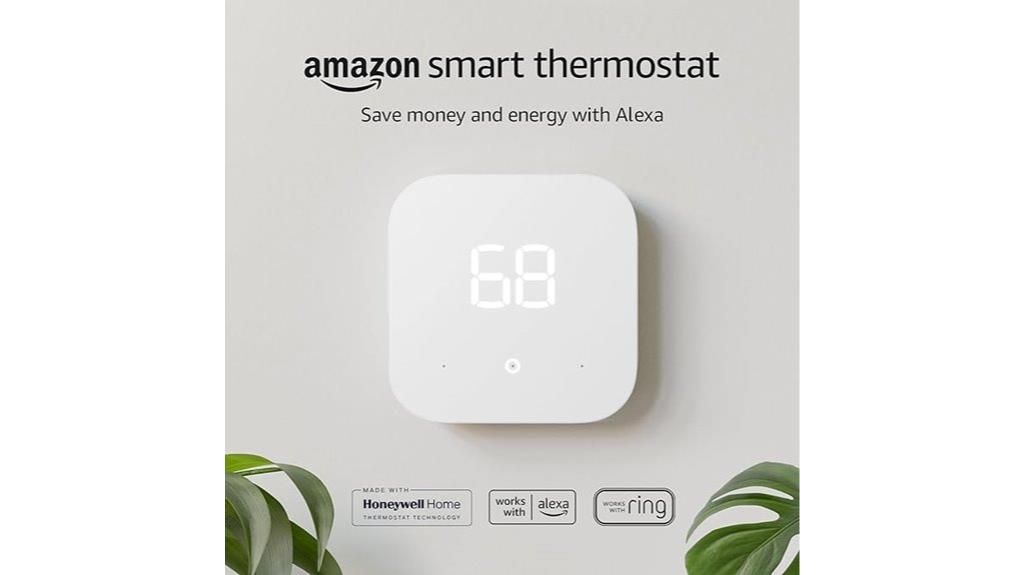
If you’re seeking a smart thermostat that seamlessly integrates with your existing Alexa devices, the Amazon Smart Thermostat is an excellent choice. It’s easy to upgrade from traditional models with its C-wire support and offers smooth compatibility with Alexa, Ring, and Echo devices like the Echo Dot. You can control the temperature remotely via the Alexa app and enjoy automatic adjustments based on your preferences and modes like home, away, or sleep. Built with trusted Honeywell technology, it’s reliable and durable. Plus, it helps reduce energy costs—saving around $50 annually according to EPA estimates—and provides guidance on potential rebates, making it a smart, cost-effective upgrade.
Best For: homeowners seeking an easy-to-install, voice-controlled smart thermostat that integrates seamlessly with Alexa and Ring devices to optimize energy savings and comfort.
Pros:
- Supports C-wire installation for straightforward setup
- Integrates effortlessly with Alexa, Ring, and Echo devices for voice control
- Helps reduce energy costs by approximately $50 annually, with guidance on potential rebates
Cons:
- Limited compatibility with non-Alexa smart home ecosystems
- Requires a C-wire for installation, which may not be available in all homes
- May not offer advanced features found in higher-end smart thermostats
ecobee Smart Thermostat Premium with Smart Sensor and Air Quality Monitor
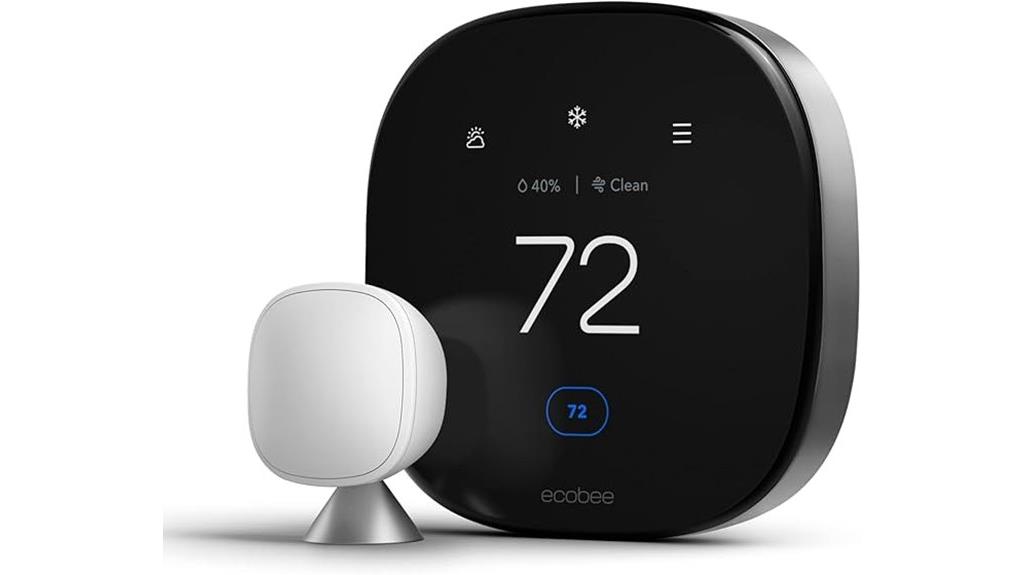
The ecobee Smart Thermostat Premium stands out for its extensive air quality monitoring and energy-saving features, making it an excellent choice for those who want both comfort and healthier indoor environments. It can save up to 26% annually on heating and cooling costs and is ENERGY STAR certified. The built-in air quality monitor alerts you to poor air conditions and offers tips for improvement, while its SmartSensor adjusts temperatures in key rooms to prevent hot or cold spots. Additionally, it detects open doors and windows, pauses HVAC to save energy, and provides notifications to prevent damage from sudden temperature drops. Its premium design and voice control options make it both stylish and user-friendly.
Best For: homeowners seeking an energy-efficient, stylish thermostat with advanced air quality monitoring and smart home integration.
Pros:
- Saves up to 26% annually on heating and cooling costs, reducing energy bills.
- Built-in air quality monitor provides real-time alerts and improvement tips for healthier indoor air.
- Compatible with most 24VAC HVAC systems and offers voice control via Siri and Alexa.
Cons:
- Requires an Apple Home Hub for Siri integration, adding extra setup for Apple users.
- Security features, such as home monitoring and alerts, need a separate ecobee Smart Security plan.
- Premium materials and features may come at a higher price point compared to basic thermostats.
Google Nest Thermostat, Programmable Wi-Fi Smart Thermostat
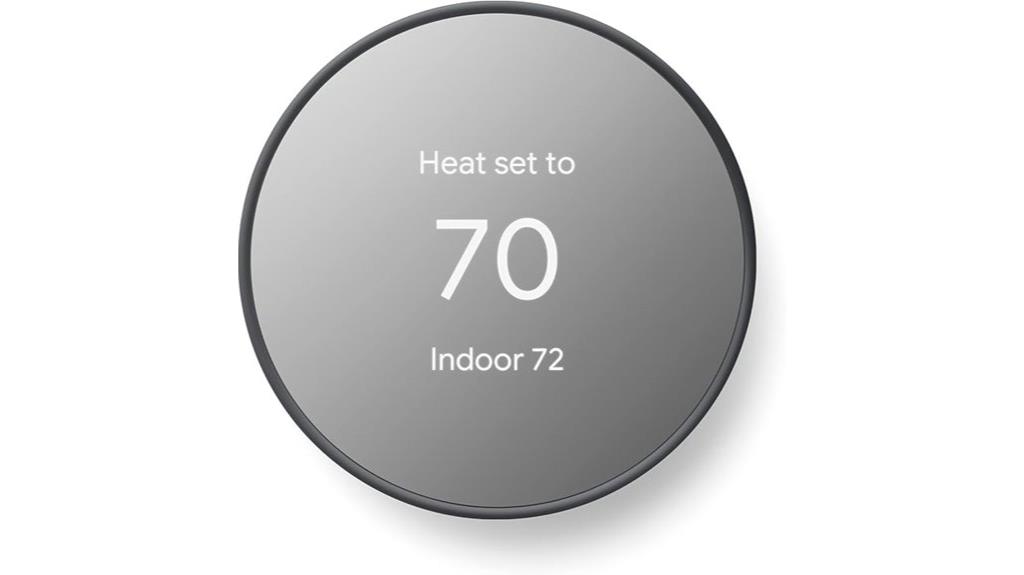
For those seeking a smart thermostat that combines ease of installation with advanced energy-saving features, the Google Nest Thermostat is an excellent choice. It’s ENERGY STAR certified, supports Wi-Fi and Bluetooth, and can be installed in about 30 minutes, often without a C wire. The sleek charcoal design features an LCD display for easy control, and it works seamlessly with the Google Home app for scheduling and remote adjustments. It learns your preferences over time, optimizing comfort and reducing energy bills. Compatible with most HVAC systems, it also provides energy insights and alerts for maintenance, making it a smart, user-friendly upgrade for any connected home.
Best For: homeowners seeking an easy-to-install, energy-efficient smart thermostat that integrates seamlessly with the Google ecosystem.
Pros:
- Easy DIY installation typically completed in 30 minutes or less
- Supports remote control and scheduling via the Google Home app for convenience
- Learns user preferences over time to optimize comfort and reduce energy bills
Cons:
- Reliance on Wi-Fi and internet connectivity for full functionality; limited offline features
- Compatibility may require a C wire or power accessory for certain HVAC systems, such as heat pumps or zone controls
- Some users have reported hardware, connectivity, or app navigation issues over time
ecobee Smart Thermostat Enhanced, Programmable Wi-Fi Thermostat
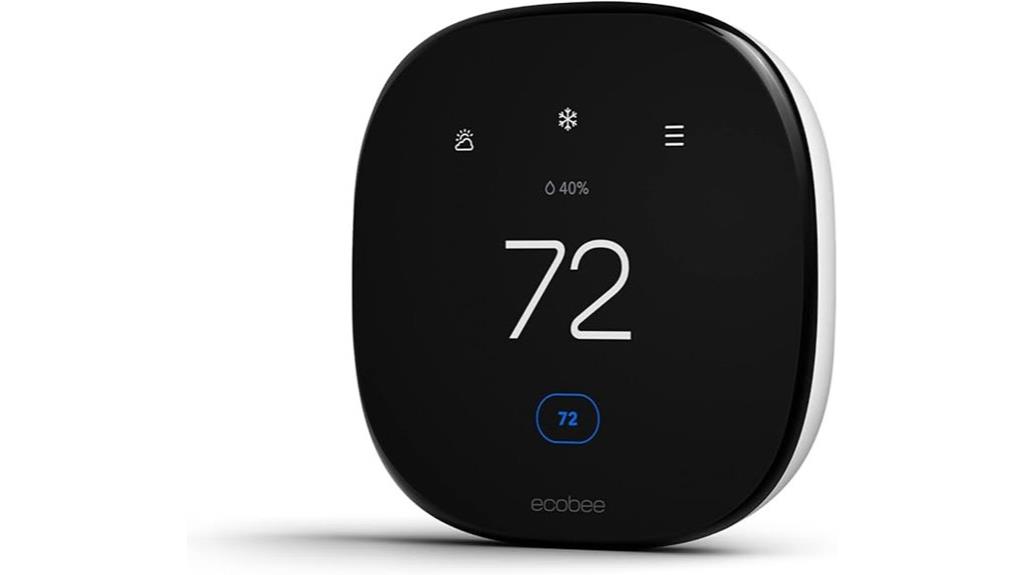
The ecobee Smart Thermostat Enhanced stands out for its advanced energy savings and comfort features, making it an excellent choice for homeowners who want to optimize their climate control. It can save up to 26% annually on heating and cooling costs by adjusting temperatures when no one’s home and preheating or precooling before arrival. Its SmartSensor monitors room-specific temperatures, ensuring key areas stay comfortable. Compatible with Siri, Alexa, and Google Assistant, I can control it remotely via the app or voice commands. Installation is straightforward, even without a C-wire, and it works with most HVAC systems, providing reliable, energy-efficient comfort.
Best For: homeowners seeking an energy-efficient, smart thermostat that seamlessly integrates with popular voice assistants and offers room-specific temperature control.
Pros:
- Saves up to 26% annually on heating and cooling costs through intelligent scheduling and adjustments.
- Compatible with most HVAC systems and supports easy installation, even without a C-wire.
- Offers remote control and voice command integration with Siri, Alexa, and Google Assistant.
Cons:
- Requires a stable Wi-Fi connection for optimal operation and remote access.
- The SmartSensor feature is optional and may involve additional cost.
- Some users might find the setup process challenging without prior technical experience.
Honeywell Wi-Fi Smart Color Thermostat
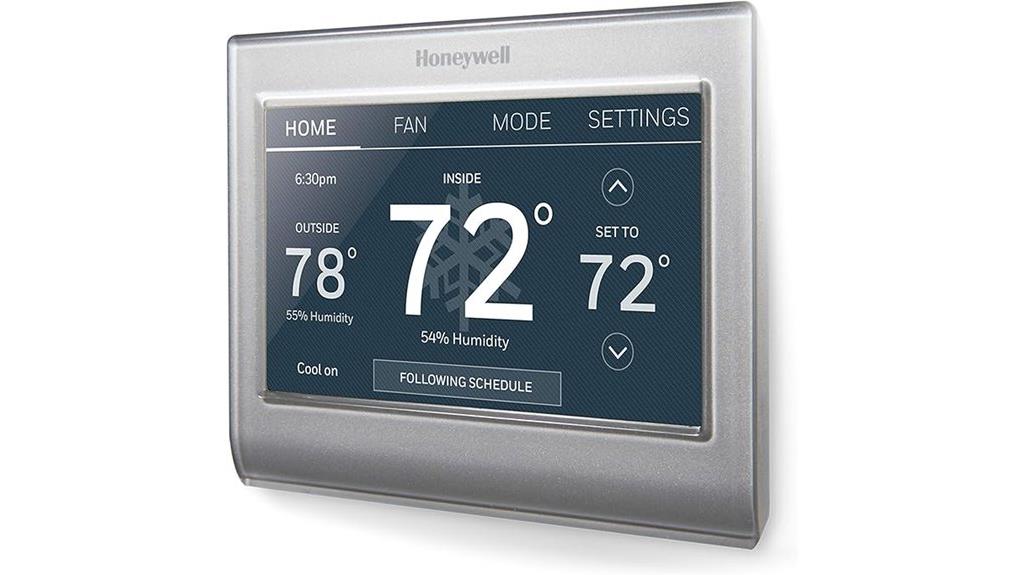
If you want a smart thermostat that combines customizable scheduling with vibrant visual appeal, the Honeywell Wi-Fi Smart Color Thermostat stands out. It offers 7-day programmable schedules, a full-color touchscreen, and easy remote control via Wi-Fi. Compatible with central AC, heat pumps, and smart platforms like Alexa, Google Home, and SmartThings, it displays indoor temperature, outdoor weather, humidity, and forecasts. Installation is straightforward for DIYers, but careful wiring is essential. Users praise its intuitive interface, responsive touchscreen, and sleek design. While some note limited fan control options and humidity lag, overall, it provides reliable, customizable climate management with a visually engaging display.
Best For: homeowners seeking a customizable, visually appealing smart thermostat with robust Wi-Fi and smart platform integration.
Pros:
- Intuitive touchscreen interface and sleek, colorful display
- Supports 7-day programmable scheduling and remote Wi-Fi control
- Compatible with popular smart platforms like Alexa, Google Home, and SmartThings
Cons:
- Limited fan control options (ON, AUTO, CIRCULATING)
- Sensitive wiring connectors may require careful handling during installation
- Humidity readings can lag or vary compared to external sensors
TEMPIQ WiFi Temperature & Humidity Sensor with App Alerts
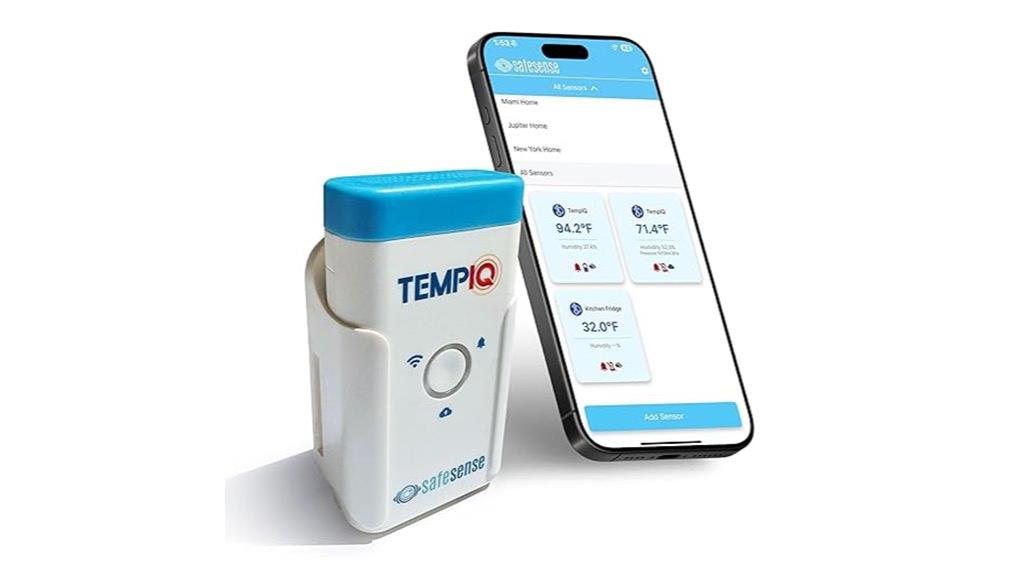
When it comes to maintaining ideal indoor conditions, the TEMPIQ WiFi Temperature & Humidity Sensor stands out with its App alerts and versatile application options. I appreciate how it monitors homes, Airbnbs, RVs, and even pets or freezers, both indoors and outdoors. Setup is straightforward—just an email, no subscriptions needed—and the free app stores unlimited data. It offers real-time alerts via push, text, or email when powered by USB, while battery mode conserves power with periodic updates. The device quickly connects via WiFi, automatically reconnecting after disruptions. Proudly made in Florida, it combines reliable performance with local craftsmanship, keeping my environment safe and monitored effortlessly.
Best For: homeowners, property managers, and pet owners seeking a reliable, easy-to-use WiFi temperature and humidity monitor with app alerts for indoor and outdoor environments.
Pros:
- No subscription fees or personal data required for setup and use
- Supports real-time alerts via push notifications, texts, and emails when plugged into USB power
- Easy to install with quick setup, automatic WiFi reconnection, and local craftsmanship support
Cons:
- Limited to 2.4GHz WiFi networks; does not support 5GHz bands
- Battery mode sends periodic readings only every 15-60 minutes, not real-time
- Requires initial Bluetooth pairing, which may be an extra step for some users
Sensi Lite Smart Thermostat
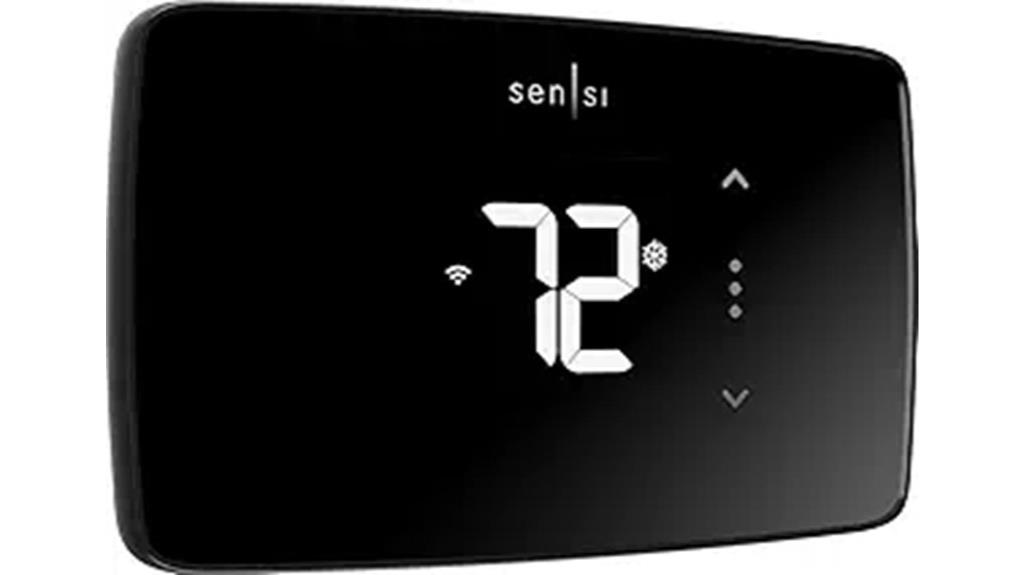
For homeowners seeking an easy-to-install, energy-efficient thermostat with manual scheduling options, the Sensi Lite Smart Thermostat by Emerson stands out. It’s Energy Star certified and compatible with various HVAC systems like boilers, heat pumps, and air conditioners. Setup is straightforward with step-by-step guides and app QR code scanning. Features include remote control, manual adjustments, geofencing, and programmable schedules. It supports Alexa, Google Assistant, and SmartThings. With a sleek LCD display and backlight, it combines style and functionality. While mostly wire-free, some systems may need a C-wire or special wiring. Overall, it offers convenient, customizable climate control and energy savings.
Best For: homeowners seeking an easy-to-install, energy-efficient thermostat with manual scheduling options and smart home compatibility.
Pros:
- Simple DIY installation with step-by-step guides and app QR code setup
- Energy Star certified, offering about 23% HVAC energy savings
- Supports remote control, manual adjustments, and integration with Alexa, Google Assistant, and SmartThings
Cons:
- Wi-Fi connectivity issues reported after power outages or battery changes
- Limited app features and scheduling flexibility compared to more advanced thermostats
- May require additional wiring or a C-wire for certain HVAC systems like heat pumps and zone controls
ecobee Smart Thermostat Enhanced – Programmable WiFi Thermostat
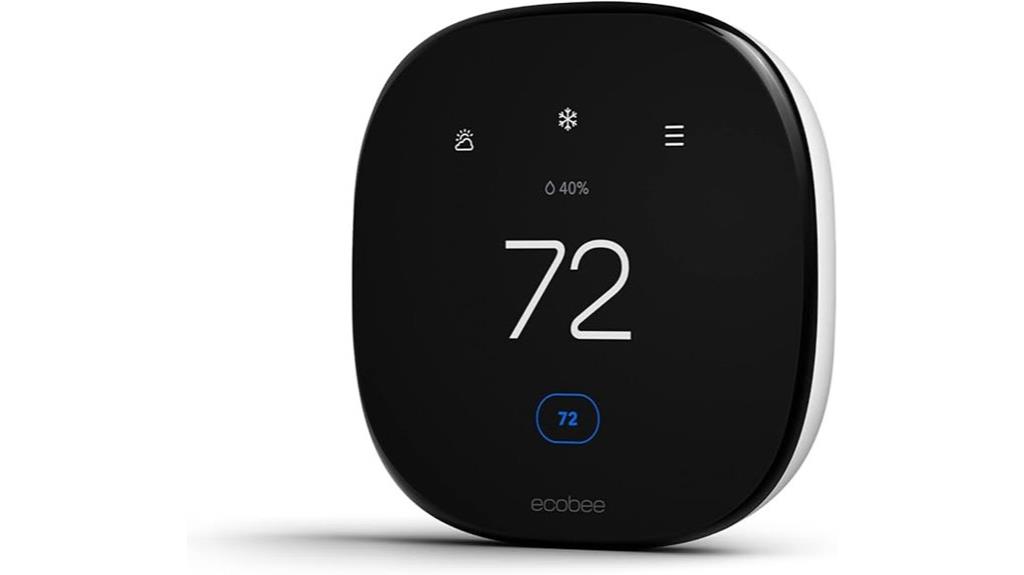
The ecobee Smart Thermostat Enhanced stands out as an excellent choice for homeowners seeking both energy efficiency and precise climate control. It can save up to 26% annually on heating and cooling costs by automatically adjusting temperatures when you’re away and preheating or precooling your home before you arrive. Its SmartSensor focuses on key areas, maintaining consistent comfort levels. Compatible with Siri, Alexa, Google Assistant, and other platforms, I can control it remotely via the Ecobee app or voice commands. Installation is straightforward, especially with the Power Extender Kit, and it works with most HVAC systems, making it a versatile, energy-efficient upgrade.
Best For: homeowners seeking a highly energy-efficient, smart, and easy-to-install thermostat that offers precise climate control and seamless smart home integration.
Pros:
- Saves up to 26% annually on heating and cooling costs through automatic adjustments and preconditioning.
- Compatible with most HVAC systems and supports multiple voice assistants including Siri, Alexa, and Google Assistant.
- Features user-friendly installation options, including the Power Extender Kit, and includes SmartSensor for room-specific temperature management.
Cons:
- Requires Wi-Fi connection for optimal functionality, which may be a concern in areas with unstable internet.
- Advanced features and setup may be overwhelming for users unfamiliar with smart home technology.
- The initial cost is higher compared to basic thermostats, which may be a consideration for budget-conscious homeowners.
Programmable Thermostat for House with Multi-Stage HVAC Control
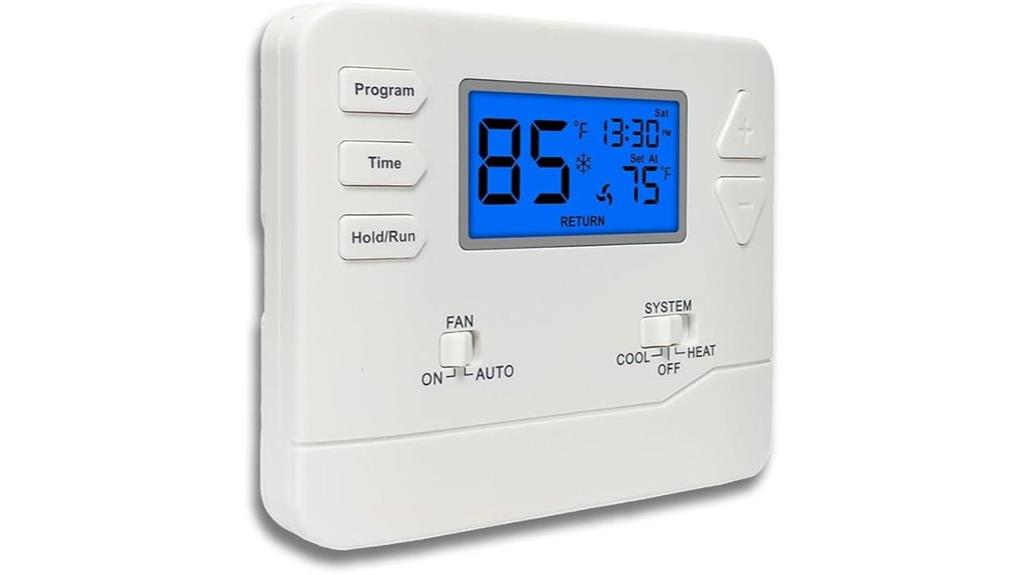
A programmable thermostat with multi-stage HVAC control is ideal for homeowners seeking precise climate management across complex heating and cooling systems. These thermostats, like the Miuputake model, support a variety of systems, including multi-stage heat, cool, electric furnaces, and heat pumps (without auxiliary heat). They offer advanced features such as multi-stage control for two heat and cool stages, backlit LCD displays, and easy-to-use push buttons. Installation is straightforward, often taking less than 30 minutes. Customers appreciate their reliability, energy savings, and compatibility with many HVAC setups, making them a smart choice for those wanting detailed control without overwhelming complexity.
Best For: homeowners with multi-stage HVAC systems seeking precise, programmable climate control with easy installation and reliable performance.
Pros:
- Supports multi-stage heating and cooling for complex HVAC setups
- Easy to install within approximately 30 minutes with clear wiring labels
- User-friendly interface with backlit LCD and intuitive controls
Cons:
- Not compatible with heat pumps with auxiliary/emergency heat or line voltage systems
- Some users report display malfunctions or programming difficulties out of the box
- Limited to 24V systems, excluding electric baseboards and mini-split systems
Home RTH6360D1002 Programmable Thermostat, 5-2 Schedule, 1-Pack, White
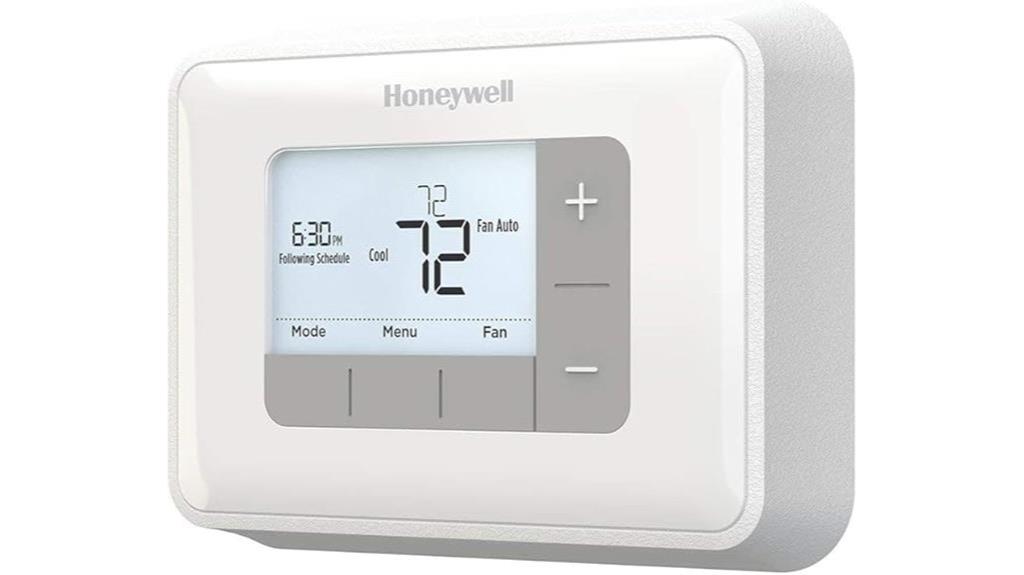
If you’re seeking a reliable thermostat that simplifies daily climate control, the Home RTH6360D1002 stands out with its flexible 5-2-Day or 1-Week programming options. It learns your heating and cooling patterns using Smart Response Technology, automatically adjusting to reach your desired temperature efficiently. The backlit LCD display makes it easy to monitor current and set temperatures at a glance. It also remembers your settings during power outages and alerts you when batteries or filters need attention. Installation is straightforward with included hardware and a quick install guide. This white, single-pack unit is a practical choice for customizable comfort and energy savings.
Best For: homeowners seeking an easy-to-program, energy-efficient thermostat with customizable scheduling and smart temperature adjustments.
Pros:
- Flexible 5-2-Day or 1-Week programming options for personalized comfort and savings
- Smart Response Technology learns your preferences for automatic, efficient adjustments
- Backlit LCD display for easy monitoring of current and set temperatures
Cons:
- May require some technical familiarity during initial setup
- Limited to single-pack installation; not suitable for multi-zone systems
- Does not include advanced features like Wi-Fi connectivity or remote access
Factors to Consider When Choosing a Smart Thermostat With Manual Schedule Option

When choosing a smart thermostat with manual scheduling options, I consider several key factors to guarantee it fits my needs. Compatibility with my HVAC system, ease of installation, and how easily I can control it through an app all matter. Plus, I look for features that help save energy while giving me flexible control over my home’s climate.
Compatibility With HVAC Systems
Choosing a smart thermostat that works seamlessly with your HVAC system requires careful attention to compatibility factors. First, you need to verify it supports your specific system type, whether it’s single-stage, multi-stage, heat pump, or electric. Compatibility with your system’s voltage, usually 24V, is essential to avoid installation issues. Additionally, check if the thermostat can operate without a C-wire or if you’ll need a power accessory, especially for older setups. It’s also important to confirm whether the thermostat’s control features match your system’s capabilities, such as multi-stage heating or zone control. Finally, confirm that the manual scheduling functions are supported and can be easily customized to suit your HVAC system’s operation, ensuring full functionality and reliable performance.
Manual Scheduling Flexibility
Manual scheduling flexibility is a key factor to contemplate because it directly impacts how easily you can customize your home’s comfort levels. With flexible manual schedules, you can set specific temperature changes at certain times without depending solely on automatic adjustments or learning algorithms. This adaptability ensures consistent comfort and helps save energy, especially if your routines are irregular or seasonal. Many smart thermostats let you create multiple schedules for weekdays and weekends, giving precise control over heating and cooling patterns. The ability to quickly modify or override schedules is essential when unexpected occupancy changes or weather shifts occur. However, some models limit scheduling to preset templates or intervals, so it’s important to choose a thermostat that offers the level of manual control you need for personalized home management.
Ease of Installation Process
Installing a smart thermostat with manual scheduling features can often be straightforward, especially if you have basic DIY skills and the right tools. Most models can be installed within 30 minutes using common tools and step-by-step online guides. Compatibility with your existing HVAC wiring, especially the presence of a C-wire, plays a key role in ease of installation. Clear instructions, visual aids, and built-in level tools make setup simpler and help prevent wiring mistakes. Some thermostats feature simplified wiring terminals designed for easy DIY installation. However, if your system has complex wiring or compatibility issues, professional installation might be the best choice to ensure everything works smoothly. Overall, many smart thermostats are designed with user-friendly features to make installation quick and hassle-free.
Connectivity and App Control
When selecting a smart thermostat with manual schedule options, ensuring reliable connectivity and seamless app control is essential. I look for a device that supports remote adjustments via a dedicated smartphone app, so I can easily change settings from anywhere. Compatibility with my home Wi-Fi, whether 2.4 GHz or 5 GHz, is vital for stable, uninterrupted connection. I also prefer thermostats that integrate with popular voice assistants like Alexa, Google Assistant, or Siri, allowing hands-free scheduling and control. The app should offer intuitive scheduling features, such as customizable daily or weekly routines and manual override options. Additionally, real-time alerts and notifications about system status or schedule changes directly through the app help me stay informed and manage my climate effortlessly.
Energy Saving Features
Energy-saving features are essential when choosing a smart thermostat with manual schedule options because they directly impact your home’s efficiency and your energy bills. Features like automatic turn-down when the house is unoccupied can cut heating and cooling costs by up to 26%. Programmable schedules let you set specific temperature adjustments for different times and days, optimizing energy use without sacrificing comfort. Many smart thermostats include sensors or learning algorithms that adapt to your occupancy patterns, making energy management more efficient. Geofencing and remote control options let you override or modify schedules when you’re away, further saving energy. Additionally, monitoring and reporting tools provide insights into your consumption, helping you fine-tune your schedules for maximum savings and reduced environmental impact.
Frequently Asked Questions
Can Manual Scheduling Override Automatic Learning Features?
You’re wondering if manual scheduling can override automatic learning features. I’ve found that many smart thermostats do allow manual schedules to take precedence, giving you direct control over your climate. Usually, setting a manual schedule either temporarily overrides or permanently replaces the learning algorithms, depending on the device. It’s best to check the specific thermostat’s settings, but generally, manual inputs can override automatic functions when needed.
How Long Can Manual Schedules Be Customized?
Think of manual schedules like a personalized playlist—they can be as long or as short as you want. I’ve found that most smart thermostats let you customize schedules for several days, sometimes even a week or more. It’s like setting your own rhythm, giving you full control over your comfort. So, the length really depends on your needs, but many systems support extended customization for better climate management.
Do Manual Schedules Sync Across Multiple Devices?
Manual schedules typically don’t sync across multiple devices automatically. I’ve noticed that most smart thermostats store your settings locally or on the device itself. However, some brands offer cloud-based apps that do sync your schedules across devices, making it easier to manage your climate from anywhere. So, if syncing matters to you, look for thermostats with robust app features and cloud connectivity to guarantee seamless control.
Are Manual Schedules Easily Adjustable After Setup?
Oh, adjusting manual schedules after setup? It’s almost too easy, I’d say! Most smart thermostats make tweaking your settings a breeze—just tap or turn a dial, and you’re golden. No need to be a tech wizard. I’ve found that once you set your preferred climate, changing it later takes seconds. So, yes, it’s simple and flexible, perfect for those who like their comfort on their own terms.
Can Manual Schedules Be Set for Specific Zones in Multi-Zone Systems?
Yes, manual schedules can often be set for specific zones in multi-zone systems. I’ve found that many smart thermostats allow you to customize settings for each zone individually, giving you precise control over your home’s climate. This feature is especially handy if different areas have varying heating or cooling needs. Just make sure your system supports multi-zone scheduling, and you’ll enjoy tailored comfort throughout your home.
Conclusion
I believe that choosing the right smart thermostat with manual schedule options truly empowers us to customize our comfort effortlessly. It’s tempting to think technology will fully automate our homes, but I’ve found that manual controls keep us connected and in control of our environment. Trust me, when you find the perfect fit, it’s like revealing a secret to a more comfortable, energy-efficient home—proving that sometimes, manual is still the best way to stay in charge.
